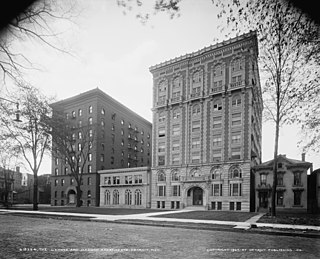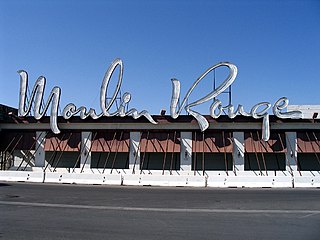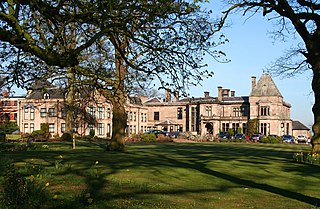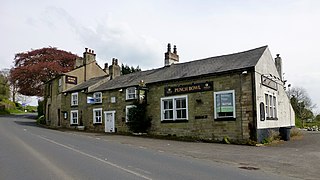| Luther Hotel | |
|---|---|
 | |
| Former names |
|
| General information | |
| Location | Palacios, Texas, United States |
| Completed | 1903 |
The Luther Hotel is a hotel in Palacios, Texas. It was built in 1903. [1]
| Luther Hotel | |
|---|---|
 | |
| Former names |
|
| General information | |
| Location | Palacios, Texas, United States |
| Completed | 1903 |
The Luther Hotel is a hotel in Palacios, Texas. It was built in 1903. [1]
The hotel, originally named the Bay View Hotel, was built in 1903 by the Texas Rice Development Company to cater to rice farmers and ranchers. [1] [2]
In 1904, the hotel was moved "around the corner" to its present location. [3] In the move, the original chimneys and porch were removed, and the east and west wings were added to the original central structure. [1] A new 300-ft porch was also added to the building, dubbed the "longest front porch in Texas". [1] The hotel was renamed the Hotel Palacios. [2]
During World War I, the hotel hosted Red Cross volunteers several times a week, who would use the time and space to sew garments for American soldiers. [3]
In 1936, a new owner, Charles Luther, bought the hotel and enclosed the porch to add more rooms. [2]
The hotel was busiest during World War II. [3] Notable visitors to the hotel during that time included Rita Hayworth and Shirley Temple. [3] These celebrities, as well as visiting bands, would entertain troops at the nearby Camp Hulen. [2] [3] In 1944, the building's top two floors were damaged by a fire. [1]
In 1961, the building was again damaged, this time by Hurricane Carla. [1] The hotel was designated as a Recorded Texas Historic Landmark in 1965. [4]
It was added to the National Register of Historic Places on May 10, 2010. [4]
In the early 2020s, the hotel's owner died without a will, placing the hotel's status into limbo. His estate sold the hotel and the land it is on to the Ed Rachal Foundation, a local charitable group that plans to demolish the hotel and build a new structure on the land. [3] The hotel is currently facing a lawsuit to determine whether or not it will be demolished, with the plaintiffs claiming the estate's executor was unaware of plans to demolish the hotel. [5] [6] [7] A preservation group based in Palacios gathered 2,000 signatures from across the state and country in favor of preserving the building. [3]

The Madison-Lenox Hotel was a hotel complex located at 200-246 Madison Street in Detroit, Michigan.

The Terre Haute House was a historic hotel in downtown Terre Haute, Indiana, United States.

Duff House is a Georgian estate house in Banff, Aberdeenshire, Scotland. Now in the care of Historic Environment Scotland, it is part of the National Galleries Scotland and is a Category A listed building.

The Moulin Rouge Hotel was a hotel and casino located in West Las Vegas that was listed on the U.S. National Register of Historic Places in 1992. Although its peak operation lasted only six months in the second half of 1955, it was the first desegregated hotel casino and was popular with many of the Black entertainers of the time, who would entertain at the other hotels and casinos and stay at the Moulin Rouge.

The Belleview-Biltmore Resort and Spa was a historic resort hotel located at 25 Belleview Boulevard in the town of Belleair, Florida, United States. The 350,000 square feet (33,000 m2) hotel structure was the last remaining grand historic hotel of its period in Florida that existed as a resort, and the only Henry Plant hotel still in operation when it closed in 2009. The building was noted for its architectural features, with its green sloped roof and white wood-sided exterior, and handcrafted woodwork and Tiffany glass inside. Constructed of native Florida heart pine wood, it was the second-largest occupied wooden structure in the United States after 1938; only the Hotel Del Coronado in San Diego was larger.

The John Anderson Lodge was an historic home built around 1886 at 71 Orchard Lane in Ormond Beach, Florida, United States. It was built for Ormond Beach promoter John Anderson (1853–1911), who was one of the first owners of the Ormond Hotel. The lodge was originally used by employees of the hotel and to host parties. In its later years it became a single family residence. The lodge was built on pilings and featured vertical palm tree wall construction.

The Traymore Hotel was a resort in Atlantic City, New Jersey. Begun as a small boarding house in 1879, the hotel expanded and became one of the city's premier resorts. As Atlantic City began to decline in its popularity as a resort town, during the 1950s and 1960s, the Traymore diminished in popularity. By the early 1970s the hotel was abandoned and severely run down. It was imploded and demolished between April and May 1972, a full four years before the New Jersey State legislature passed the referendum that legalized gambling in Atlantic City.

The Weatherford Hotel is a historic hotel in the downtown district of Flagstaff, Arizona. The hotel was established in 1897 by John W. Weatherford, and is located at 23 North Leroux Street, one block north of U.S. Route 66.

The Rice, formerly the Rice Hotel, is an historic building at 909 Texas Avenue in Downtown Houston, Texas, United States. The current building is the third to occupy the site. It was completed in 1913 on the site of the former Capitol building of the Republic of Texas, and is listed on the National Register of Historic Places. The old Capitol building was operated as a hotel until it was torn down and replaced by a new hotel around 1881. Jesse H. Jones built a new seventeen-story, double-winged hotel in 1913, also called "The Rice Hotel." This building underwent major expansions: adding a third wing in 1925, adding an eighteenth floor in 1951, and adding a five-story "motor lobby" in 1958. In addition, there were several renovations during its life as a hotel. It continued to operate as a hotel before finally shutting down in 1977. After standing vacant for twenty-one years, The Rice was renovated as apartments and reopened in 1998 as the Post Rice Lofts. It was sold in 2014 and renamed simply The Rice.



The Sugar Hill Historic District is a historic district in Detroit, Michigan. It contains 14 structures located along three streets: East Forest, Garfield, and East Canfield, between Woodward Avenue on the west and John R. on the east. The district was listed on the National Register of Historic Places in 2003.

The Davenport Hotel was a historic building located in downtown Davenport, Iowa, United States. It was individually listed on the National Register of Historic Places in 1983. In 2020 it was included as a contributing property in the Davenport Downtown Commercial Historic District. It was an apartment building called The Davenport. A rear portion of the building collapsed in 2023. The majority of the building was demolished on June 12, 2023. Several remaining sections were demolished over the next three days.

Northfield Manor House is a Manor House, on Bristol Road South, Northfield, Birmingham, England. It was formerly known as Manor Farm, and under that name was home to George and Elizabeth Cadbury.

The Empress Hotel was a three-storey red-brick building at the corner of Yonge and Gould streets in downtown Toronto. It was destroyed by fire on January 3, 2011. The hotel was opened in 1888. The hotel changed hands several times. The property ceased operating as a hotel in the mid-1970s.

In 1870, the Louisville and Nashville Railroad was constructed through the southernmost section of Harrison County, Mississippi, connecting New Orleans, Louisiana, and Mobile, Alabama. A northern transportation route into south Mississippi was provided by the Gulf and Ship Island Railroad at the turn of the 20th century. These railroads provided an inexpensive means for moving passengers as well as goods, and opened south Mississippi to both industrial and recreational development. Rapidly progressing lumber and seafood industries transformed the Mississippi Gulf Coast in the 1920s, and people arrived from throughout the United States to take advantage of the economic boom. Northern tourists were attracted to the Mississippi Gulf Coast because of mild winters and cool sea breezes in summer, before the introduction of air conditioning. Besides the weather, other tourist attractions included seafood restaurants, swimming, golf, schooner races, sailing to offshore islands, and recreational fishing. During this period of economic expansion, grand hotels were constructed along the Mississippi Gulf Coast to accommodate businessmen, tourists, and transient workers. Most of these grand hotels no longer exist; and of the two structures that were still standing after the first decade of the 21st century, neither served as a lodging establishment. Together, these grand hotels represented an important era in the history of the Mississippi Gulf Coast throughout the 20th century.

The Isaac Heffron House is a two-story building located at 1509 Postoffice Street in the East End Historic District of Galveston, Texas. The house was built by Isaac Heffron, a prominent Galveston contractor in the Victorian period and during the city's recovery from the 1900 Galveston Hurricane. Later, the house was the residence of T.J. Holbrook, a Texas state senator from 1922 to 1939.

Hotel Marcel is a Hilton hotel in the Long Wharf district of New Haven, Connecticut. It is housed in the Armstrong Rubber Company Building, later known as the Pirelli Tire Building: a former office building designed by modernist architect Marcel Breuer. The structure is a noted example of Brutalist architecture. Since its renovation into a hotel, the building operates as a zero-energy building, generating enough renewable energy to sustain its operations.

The Ewalt House was a historic house in the Lawrenceville neighborhood of Pittsburgh, Pennsylvania, and a contributing property in the Lawrenceville Historic District. It was built as a country estate sometime between 1787 and 1840 by Samuel Ewalt, and remained standing after most of the land was subdivided for residential lots in the 1870s. The house was notable as a rare example of an antebellum Greek Revival house in Pittsburgh, and exemplified the typical pattern of development in Lawrenceville in the mid to late 19th century. In 2019, the building was nominated as a Pittsburgh historic landmark.
